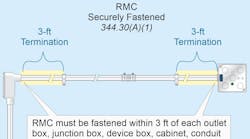Underlined text indicates a change in the rules for the 2017 NEC.
Q. What are the NEC requirements for raceways exposed to different temperatures?
Scroll Down to See the Answer
A. If a raceway is subjected to different temperatures, and where condensation is known to be a problem, the raceway must be filled with a material approved by the authority having jurisdiction (AHJ) that will prevent the circulation of warm air to a colder section of the raceway. An explosionproof seal isn’t required for this purpose [300.7(A)]. Putty or duct seal in the raceway is a typical method to accomplish this requirement.
Where necessary to compensate for thermal expansion, deflection, and contraction, raceways must be provided with expansion, expansion‑deflection, and deflection fittings [300.7(B)].
Informational Note: Table 352.44 provides the expansion characteristics for PVC conduit. The expansion characteristics for steel conduit are determined by multiplying the values from Table 352.44 by 0.20, and the expansion characteristics for aluminum raceways are determined by multiplying the values from Table 352.44 by 0.40. Table 354.44 provides the expansion characteristics for reinforced thermosetting resin conduit (RTRC).



